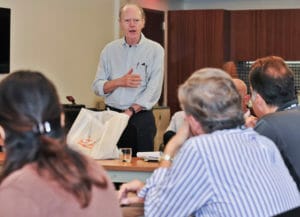Top Story
The need to plan and build for greater resilience has acquired a sense of urgency as severe weather events occur with greater frequency and intensity. Extreme events such as Hurricane Katrina and Superstorm Sandy are sobering reminders of the costs and consequences of underestimating the risks posed by natural disasters.
Earlier this month, ULI hosted a webinar for members on resources that can assist civic, business, and nonprofit leaders as they build more environmentally and economically resilient communities. These resources, in the form of white papers that can be downloaded at uli.org, were developed by ULI members who have extensive experience advising public and private sector clients on climate change mitigation and adaption strategies. During the webinar, the author of each report explained how each tool or analysis can be used by cities as they undertake resiliency planning.
While strategies to cope with climate change are a work in progress, what is clearer now is the root cause of the severe weather events. “We are witnessing rising global temperatures that are, in fact, behind a host of climate disruptions,” noted Sarene Marshall, executive director of the ULI Center for Sustainability, as she introduced the panel. Droughts, hurricanes, and storms are becoming more severe; sea levels are rising in coastal regions as a result of a combination of melting polar ice, warming ocean waters, and diminishing mountain snowpacks.
According to webinar panelists, resilience is neither disaster prevention and preparedness nor simply replacing assets as they existed before an event. Rather, resilience means “bouncing forward, not just bouncing back—to recover and improve the ability to withstand future stresses,” said John McIlwain, a former ULI senior resident fellow who is now a senior adviser to the Jonathan Rose Companies.
Resiliency Planning 101 One challenging aspect of resiliency planning is knowing where to start. The white paper “Resilience Strategies for Communities at Risk” provides a comprehensive overview of how communities can break their efforts down into discrete, actionable steps.
The report expands on recommendations made by a special ULI Advisory Services panel convened in July 2013 to address the impacts of Hurricane Sandy on communities in the U.S. Northeast. McIlwain, coauthor of the white paper and a member of the Sandy panel, described core resilience strategies detailed in the report that stakeholders should examine through the resilience planning process. They fall into four categories:
Land Use and Development The report recommends that sections of a town, city, or region be evaluated according to how difficult or easy each area is to protect, as well as how valuable the area’s assets are to the community. Wall Street in New York City’s Financial District, for example, is difficult to protect from extreme weather because it sits adjacent to water, yet its assets are critical not only to the national economy, but also to global financial markets.
Noting that low-income residents often live on the most vulnerable land, McIlwain discussed equity considerations that must be factored into the decision of whether to rebuild versus requiring people to move to less vulnerable neighborhoods. The goal is to gradually reduce investments in hard-to-protect areas, although the decision to do so can be complicated and politically charged.
Infrastructure/Technology All infrastructure—highways, bridges, transit systems, telecommunications, and water and power supplies—must be thought of in regional terms, requiring a cooperative approach before, during, and after an extreme weather event. “A regional vision needs to be created for what would be a robust and resilient infrastructure for the region, and priorities need to be set as to where to put money as it comes in, as no region has enough money to do all the work that is necessary,” McIlwain explained.
Finance/Investment/Insurance It may be a human tendency to underestimate future risk, but those instincts need to be overridden. “The first and foremost important thing is to fully and fairly price risk, whether it’s property price, insurance, or the cost of financing” to rebuild, McIlwain said. “By fully pricing risk, it makes it easy to decide where to build, how to build, how to finance, and how to insure.” In addition, insurance, both federal and private, should move away from an “all or nothing” model to one in which incremental steps taken to reduce risks count toward lower premiums, McIlwain said.
Leadership/Governance/Local Capacity In the wake of a natural disaster, the stream of federal and state dollars that flows to a municipality can be dizzying. Yet local officials are often hamstrung in how they respond to a disaster because of decisions made at the state or federal level about where the money should go. The report recommends devolving funding and decision making to the local level so that communities affected by an extreme weather event are in control. Increasing the capability of local entities to develop resilience plans is also paramount. Citing his experience on the Sandy panel, McIlwain said the leadership of towns along the Jersey shore devastated by the storm was so bare bones that those leaders could only react to present-day disasters instead of planning for future ones.
Download this resource here.
Fairly Assessing and Pricing Risk
Byron Stigge, founder of Level Infrastructure, an engineering consulting firm based in New York City, developed the six-step process outlined in “A Guide for Assessing Climate Change Risk.” An accurate assessment of risk is vital to resilience planning so that limited resources can be stretched, he said. “Risk assessment helps organizations understand which are the highest-priority areas, neighborhoods, or types of events to focus on so they are doing projects that will build resilience in the most cost-effective way.” The six steps are:
- Define all the hazards or extreme weather events your community is likely to face.
- Determine the likelihood and severity of each event to create an “event scenario.” Is it a high-frequency event that causes minimal damage, or a low-frequency event that results in major losses?
- Identify all assets and facilities—from utility lines to power plants to hospitals—that are vulnerable to each type of hazard.
- Estimate the damage to each asset, factoring in the direct impacts, like property damage and loss of business revenue, and indirect impacts, like reduced home values, job losses, and higher insurance rates.
- Add up the risks to each asset from each event scenario—the everyday storms that cause minimal damage as well as the 100-year storm events that cause maximum damage—to understand the annual risk exposure for your community.
- Figure out what the cumulative risks are for your community over the next 30 to 50 years.This risk assessment can be applied to any community.Download this resource here.
Different Strategies for Different Land Types Every region is composed of distinct land types, from sparsely populated wild and rural areas to suburban developments and high-density urban cores. Transect is a term coined by the new urbanist movement to describe these different land types that exist along a continuum.
Each land type requires a tailored approach when it comes to resilience, according to Jim Heid, founder and president of UrbanGreen and author of “Resilience Strategies along the Rural–Urban Transect.” The need for a land type–specific approach was evident during a ULI Advisory Services panel held last year in northern Colorado, where three distinct communities—Estes Park, a mountain village; Fort Collins, the fourth-largest city in Colorado; and Loveland, a growing suburb—sought advice on how to develop resiliency after record storms, flooding, and wildfires in 2013. (Read the northern Colorado report here.)
In rural and undeveloped areas, it may be appropriate to “let rivers be rivers,” according to Heid. “Instead of trying to channelize, armor, and control rivers, it might be cheaper, more sustainable, and ecologically appropriate to acquire those lands and let the rivers flood as they need to in order to protect downstream asset values.”
Suburban areas and towns can develop resilience by taking an integrated approach—parks departments and utility districts joining forces to address climate impacts while offering a public benefit. Urban stormwater runoff is the major source of flooding in urban areas. In Bellevue, Washington, Heid noted, officials have moved away from a channelized stormwater treatment system in favor of natural systems to filter and absorb stormwater. The result has been cleaner stormwater, a reduction in flooding, and a more efficient use of public dollars.
Cities are more constrained than rural areas when it comes to developing resilience plans because of the large amount of economic investment in and private ownership of individual buildings, Heid said. Yet, cities can also create infrastructure that serves dual purposes, as is the case with Guadalupe River Park in San Jose, California, where the river had to be redirected through hard infrastructure. The city has turned the site of that infrastructure into a public plaza and trail.
Ultimately, resilience is not merely a box to tick off, but “an important lens when we do development and planning,” Heid said. “It’s a journey, not a destination. It’s never achieved, but a continuum that we work towards over time through constant actions and evolution.” Download this resource here.


